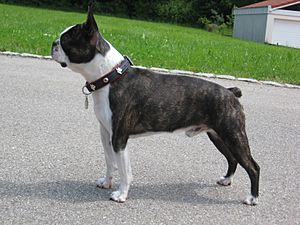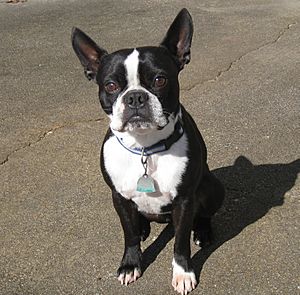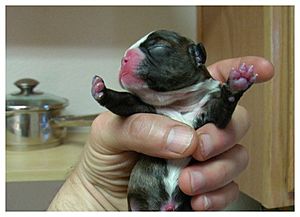Boston Terrier facts for kids

Boston Terrier with a black brindle coat
|
|||||||||||||||||||||||||||||
| Other names |
|
||||||||||||||||||||||||||||
|---|---|---|---|---|---|---|---|---|---|---|---|---|---|---|---|---|---|---|---|---|---|---|---|---|---|---|---|---|---|
| Origin | United States | ||||||||||||||||||||||||||||
|
|||||||||||||||||||||||||||||
|
|||||||||||||||||||||||||||||
| Notes | State dog of Massachusetts | ||||||||||||||||||||||||||||
| Domestic dog (Canis lupus familiaris) | |||||||||||||||||||||||||||||
The Boston Terrier is a breed of dog originating in the United States of America. This "American Gentleman" was accepted in 1893 by the American Kennel Club as a non-sporting breed. Boston Terriers are small and compact with a short tail and erect ears.
The Boston Terrier ranked as the 24th most popular breed in registrations with the American Kennel Club in 2022.
Contents
History
The Boston terrier breed originated around 1870, when Robert C. Hooper of Boston purchased from a man named William O'Brien a dog named Judge (known later as Hooper's Judge), which was of a bull and terrier type lineage. Hooper's Judge is directly related to the original bull and terrier breeds of the 19th and early 20th centuries. The American Kennel Club cites Hooper's Judge as the ancestor of nearly all true modern Boston Terriers.
Judge weighed about 32 pounds (15 kg). Judge was bred to Edward Burnett's bitch named Gyp (or Kate). Gyp was a white bulldog-type female, owned by Edward Burnett, of Southboro, Massachusetts. She weighed about 20 pounds (9.1 kg), was stocky and strong and had the typical blocky head now shown in Bostons. From this foundation of the breed, subsequent breeders refined the breed into its modern-day presentation. Bred down in size from fighting dogs of the bull and terrier types, the Boston Terrier originally weighed up to 44 pounds (20 kg) (Old Boston Bulldogs).
The Boston Terrier Club was formed in 1891; it was admitted to membership in the American Kennel Club in 1893. It is one of a small number of breeds to have originated in the United States.
In the early years, the color and markings were not very important to the breed's standard. By the 20th century the breed's distinctive markings and color were written into the standard, becoming an essential feature. The Boston Terrier has lost most of its aggressive nature, preferring the company of humans, although some males will still challenge other dogs if they feel their territory is being invaded. Boston University has used Rhett the Boston Terrier as their mascot since 1922. The Boston Terrier has also been the official state dog of Massachusetts since 1979.
Description
The Boston Terrier is a compactly built, well-proportioned dog. It has a square-looking head with erect ears and a slightly arched neck. The muzzle is short and generally wrinkle-free, with an even or a slightly undershot bite. The chest is broad and the tail is short. According to international breed standards, the dog should weigh no more than 25 pounds (11 kg). Boston Terriers usually stand up to 15–17 inches (380–430 mm) at the withers.
The American Kennel Club divides the breed into three classes: under 15 pounds, 15 pounds and under 20 pounds, 20 pounds and not exceeding 25 pounds.
Coat and color
The Boston Terrier is characteristically marked with white in proportion to either black, brindle, seal (seal appears as black with a red cast in lighting), or a combination of the three. Solid colours and colours not mentioned are not accepted by the breed standard. According to the American Kennel Club, the Boston Terrier's markings are broken down into two categories: Required, which consists of a white chest, white muzzle band, and a white band between the eyes; and Desired, which includes the Required markings plus a white collar, white on the forelegs, up to the hocks on the rear legs. For conformation showing, symmetrical markings are preferred. Due to the Boston Terrier's markings resembling formal wear, in addition to its refined and pleasant personality, the breed is commonly referred to as "the American Gentleman."
Notable features
The Boston Terrier's large, prominent pair of eyes is a distinguishable feature. The breed's round eyes are set widely apart, are large in size, and located squarely in the skull.
The breed's genetic makeup produces a short tail. These short tails can take the shape of a corkscrew, or curl, or they can be straight. Generally, Boston Terriers' tails do not exceed 2 inches (51 mm) in length.
Temperament
Boston Terrier is a gentle breed that typically has a strong, happy-go-lucky, and friendly personality with a merry sense of humor. Boston Terriers are generally eager to please their owner and can be easily trained.Template:Bettersourceneeded They can be very protective of their owners, which may result in aggressive and territorial behavior toward other pets and strangers.
Both females and males are generally quiet and bark only when necessary. Their usually sensible attitude toward barking makes them excellent choices for apartment dwellers.Template:Bettersourceneeded They enjoy being around people, get along well with children, the elderly, other canines, and non-canine pets, if properly socialized.
Diet
Just like you need vitamins and minerals, Boston Terriers need certain nutrients to stay healthy. These include:
- Protein: This helps build and repair muscles. Think of it as the building blocks for their body.
- Fats: These give them energy and help keep their skin and coat healthy.
- Carbohydrates: These also give them energy.
- Vitamins and Minerals: These help their body work properly.
- Water: This is super important for keeping them hydrated and healthy.
The amount of food a Boston Terrier needs depends on a few things:
- Age: Puppies need more food than adult dogs because they are growing.
- Size: Bigger Boston Terriers might need more food than smaller ones.
- Activity Level: Dogs that run and play a lot need more food than dogs that mostly relax.
Generally, adult Boston Terriers need about 1 to 1.5 cups of dry food per day, split into two meals. Puppies might need more, and you should always check with your vet to be sure.
Avoid giving your dog:
- Chocolate: This is poisonous to dogs!
- Grapes and raisins: These can cause kidney problems.
- Onions and garlic: These can damage their red blood cells.
- Salty or fatty foods: These can make them sick.
Health
A 2024 UK study found a life expectancy of 11.8 years for the breed compared to an average of 12.7 for purebreeds and 12 for crossbreeds.
Curvature of the back, called roaching, might be caused by patella problems with the rear legs, which in turn causes the dog to lean forward onto the forelegs.
The Boston Terrier is a brachycephalic breed of dog. Brachycephaly refers to the shortened muzzle of the breed which results in a pushed-in appearance of the face. Brachycephaly results in deformation of the upper airway tract and leads to obstruction of breathing. Effects of brachycephaly are stridor, stertorous breathing, emesis, skin fold dermatitis, brachycephalic airway obstructive syndrome, exophthalmos, pharyngeal gag reflex, cyanosis, and laryngeal collapse. Other issues arising from brachycephaly are risk of complications whilst under anaesthesia, and hyperthermia — with the latter caused due to an inability to effectively reduce body temperature via panting.
Bostons frequently require caesarean section to give birth, with over 80% of litters in a UK Kennel Club survey delivered this way.
The breed is predisposed to the following dermatological conditions: atopic dermatitis, allergic skin disease, demodicosis, hyperadrenocorticism, mast cell tumour, pattern alopecia, and zinc-responsive dermatosis.
A study in North America of veterinary records of almost 10,000 Boston Terriers and over 1,000,000 dogs found 0.36% of Boston Terriers to have hip dysplasia compared to 3.52% overall.
The Boston Terrier is one of the most commonly affected breeds for hereditary cataracts.
Popular Boston Terriers
In 1921 at a ceremony to commemorate the United States' 102nd Infantry, the U.S. Army awarded a gold medal to an honorable war dog: Sergeant Stubby. The Boston Bull Terrier, possessing three service stripes and one wound stripe, was given a rank in the U.S. Army-making him the first dog to ever earn it. The comforting, protective war dog was also rewarded a medal by France. Sergeant Stubby died in 1926 with the legacy of being the United States' "greatest war dog."
Wofford College in Spartanburg, SC has had a live Boston Terrier mascot named Blitz since 2003 that attends home football games.
In 2012, a high school student named Victoria Reed took the advice of her veterinarian and submitted a photo of her Boston Terrier, Bruschi, to Guinness World Records. With each eye being 1.1 inches, or 28 mm, in diameter, Bruschi is recognized by Guinness to be the dog with the largest eyes.
Lennu, the pet from 2012 to 2021 of Sauli Niinistö, the President of Finland, was present at many of his less formal appearances and well known in Finland. Photos of the pair went viral in the United States in 2017.
Related Pages
Images for kids
See also
 In Spanish: Boston terrier para niños
In Spanish: Boston terrier para niños
- Dogs portal
- List of dog breeds
- Bull-and-terrier
- Bull-type terriers







